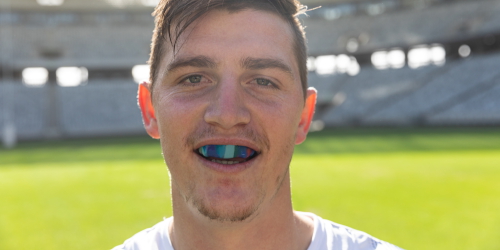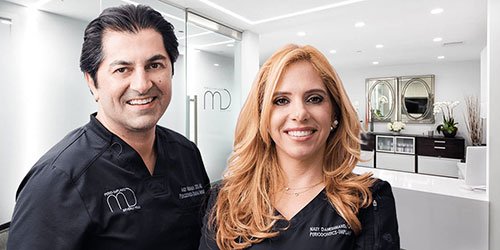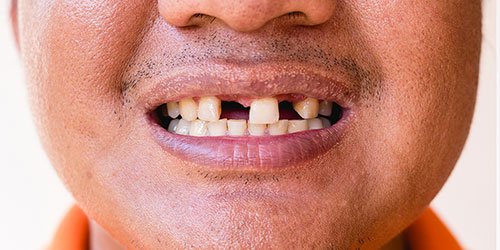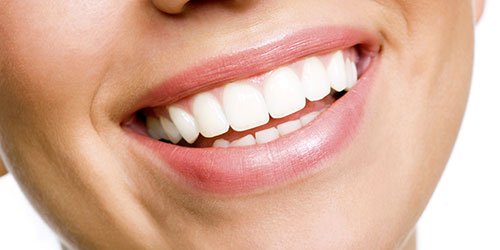Tooth Loss is no Laughing Matter
No matter what the cause, teeth that are missing or damaged can be a source of anxiety, discomfort, and insecurity. Whether it’s one tooth, several teeth, or even a mouthful of teeth that need replacing, the experienced specialists at MD Periodontics have the best training and experience in restorative dentistry in Los Angeles. Our skilled periodontists will revitalize the function and appearance of your mouth.

Tooth wear and loss can be due to a wide range of factors including:
- Injury
- An unbalanced diet
- Inadequate dental care
- Medical conditions
- Medications causing acid reflux or changes in saliva composition
- Bite malalignment
- Common behaviors such as tooth grinding
When to consider tooth replacement
While a dental practitioner’s primary goal is to preserve your natural teeth whenever possible, in those cases when a tooth can’t be salvaged, it becomes necessary to replace the damaged or missing tooth (or several teeth) with a dental prosthesis.
It’s important to fill in gaps in the mouth to prevent cavities. Plaque-causing bacteria can form in the gaps. Also, if you are missing teeth, you have less surface area for chewing. This places additional stress on your remaining teeth. These issues can harm not only your oral health but your general health.
Dental professionals use a variety of tools to replace missing or damaged teeth. As mentioned, replacing teeth not only restores your natural smile and normal function, it prevents future oral health problems. Your dentist can recommend many different treatment options. Fillings, crowns, braces, bridges, dentures, and dental implant procedures can be used individually or in combination to repair worn, damaged, or missing teeth and restore your healthy smile.
Dentures provide a temporary and removable solution for replacing missing teeth and are an affordable tooth replacement option. However, there are some situations in which patients’ natural teeth are unable to support dentures. That’s where implants come in.
Why consider a dental implant?
A dental implant is a permanent tooth replacement option when you’re missing one or more teeth. The implant replaces the tooth root and supports a crown that looks and works exactly like a natural tooth. The biggest advantage of a dental implant instead of a bridge is that an implant doesn’t affect the neighboring teeth.

When a traditional bridge is fabricated to fill in a gap left by one or more missing teeth, the bridge is attached to a healthy tooth flanking either side of the gap. This requires fitting the neighboring teeth with crowns to support the daily stress of inserting and removing the bridge. So, in order to support a bridge, two healthy teeth must be ground down and capped with a crown.
Benefits of Implants over Bridges
For this reason, some patients choose to get dental implants instead of bridges to keep the natural teeth flanking a missing tooth intact. Also, in some cases, natural teeth are missing or unable to support removable bridges or partial dentures. Your tooth function and natural appearance can instead be restored with permanent dental implants.
Many folks elect to replace their bridges with dental implants because of the difficulty of maintaining bridges. Removable bridges require daily removal, cleaning, and soaking and also make flossing difficult. The increased maintenance puts patients at increased risk of developing gum disease.
Dental implants enhance not only your quality of life but your physical comfort level. Most people are very self-conscious when their smile reveals large gaps or no teeth at all. Having beautiful, functional teeth that are as comfortable as natural teeth is a priceless experience.
What to expect when getting a dental implant
The first step in obtaining a dental implant involves undergoing an evaluation and consultation. Your periodontist will check and ensure there is enough underlying bone support to resist chewing forces. This often depends on the degree of tooth loss, how long the tooth has been missing, and the location of the missing tooth or teeth. In cases where there has been extensive bone loss, a bone graft might be necessary. A bone graft increases the bone density to create the necessary support to accommodate implants.
Our periodontists use state-of-the-art technology including special 3-D imaging (known as a CBCT) to assess the quantity of underlying jawbone at the proposed implant site, the configuration of the damaged tooth or gap, and its position relative to your other teeth. We use top-of-the-line technology for this step because detailed imaging is critical for accurate treatment planning.
Then, we review the CT image with you, explain your situation, and review available treatment strategies for restoring your oral health. We take into consideration not only your health needs but your financial requirements.
Types of Dental Implants
Because each mouth poses a unique challenge, our tool kit includes a variety of smile-restoring solutions based on your specific needs, such as:
Single dental implant and multiple tooth implants
Your doctor uses the same process when placing a single replacement tooth implant or multiple implants. Threaded implant posts, which can be made of titanium or zirconia (a ceramic material) are placed in the jaw, where they will bond with the bone (a process called osseointegration). During your consultation, you and your doctor will discuss which is the best dental implant for you.
This integration process takes several weeks. Once the threaded posts have solidly fused to your jawbone, you’ll follow up with your dentist to have your permanent porcelain or ceramic artificial teeth attached to the posts.
Depending on the number of teeth that require replacing, your dentist might insert one or several posts to support your artificial teeth.
All-on-4 dental implants
If many adjacent teeth need replacing, we might recommend the All-on-4 implant system. Using this system, several artificial teeth are permanently affixed to your jawbone using a single screw. Learn more about All-on-4 dental implants.
No-Slip Dentures with Implants and Bridges combined with Implants
Bridges, partial dentures, and full dentures can be made to work in conjunction with implants. Attaching dentures to implants, rather than securing them to the natural teeth, greatly increases stability and comfort.
Traditional bridges and dentures are attached to natural teeth and frequently slip. Even worse, they may not fit well, making eating and even talking uncomfortable. Over time, the load of supporting the bridge can compromise your natural teeth, putting them in jeopardy.
Permanent Dentures and Removable Dentures are now possible with implants!
Full dentures are complete sets of artificial teeth for the upper, lower, or both jaws. These are even more uncomfortable than partial dentures that only replace a few teeth. Full dentures are attached to your gums using messy adhesives that are not completely effective in keeping them from shifting.

With implant rehabilitation, it is now possible to secure full dentures to the upper and lower jaw using several implant posts, making the dentures strong and stable. They can be permanently inserted or, if needed, formatted to be removable.
Removable implant dentures snap onto the implant posts, allowing them to be removed for cleaning. There is no longer any need to fuss with gooey, messy adhesives or worry about your dentures shifting and making noise while talking or chewing.
If a patient requires full mouth reconstruction, a full set of permanent implant dentures can be fabricated. The entire arcs of upper and lower teeth can be permanently affixed using four to six posts.
Why trust MD Periodontics to create your perfect and natural-looking dental implants?
- Experience: Drs. Moshrefi and Daneshmand have almost 40 years of combined experience in periodontics, dental implant surgery, and restorative dentistry. They have served as faculty at USC School of Dentistry and offer the latest technology in implant dentistry available in the U.S.
- Dental Artistry: A periodontist and oral surgeon are dental implant specialists, but simply placing implants does not create the most beautiful smile. That takes a special talent and only the most gifted artisans can deliver the best results. That is what our doctors are known for. Our full-arch restorations are second to none in both the Los Angeles and Beverly Hills areas and are one of our most demanded services.
Just look at our complete dental implant before and after pictures to see for yourself.
- Personal Attention: At MD Periodontics, we know that every patient is different. That is why our experienced implant specialists take the time to fully understand your dental needs.
- State-of-the-Art Dental Office: Besides having the very best equipment available anywhere for our patient’s care, we also provide our patients with a beautiful facility where they can relax, something very unexpected but extremely comforting. We feature calm and neutral colors, with soft lighting throughout. We are also conveniently located in Beverly Hills with ample parking to make your experience distraction-free.
To schedule a consultation, click here or call us at (310) 859-9449. Your smile will thank you!
We are conveniently located to patients throughout Southern California and the Los Angeles area. Our Beverly Hills office is conveniently located near West Los Angeles, Culver City, West Hollywood, Downtown Los Angeles, Marina del Rey, Pacific Palisades, Malibu, Manhattan Beach, Sherman Oaks, and Encino.
- How To Pick The Best Dental Implant Specialist Near Me - September 17, 2024
- Can Bleeding Gums Be a Symptom of Something More Serious? - May 27, 2024
- What Is Hydroxyapatite Toothpaste, and Is It Better for You? - May 1, 2024
 (310) 859-9449
(310) 859-9449 Dental Implants in 2024, What You Need to Know
Dental Implants in 2024, What You Need to Know















































